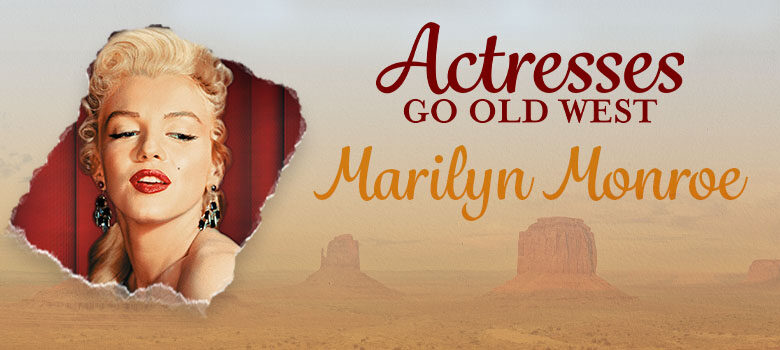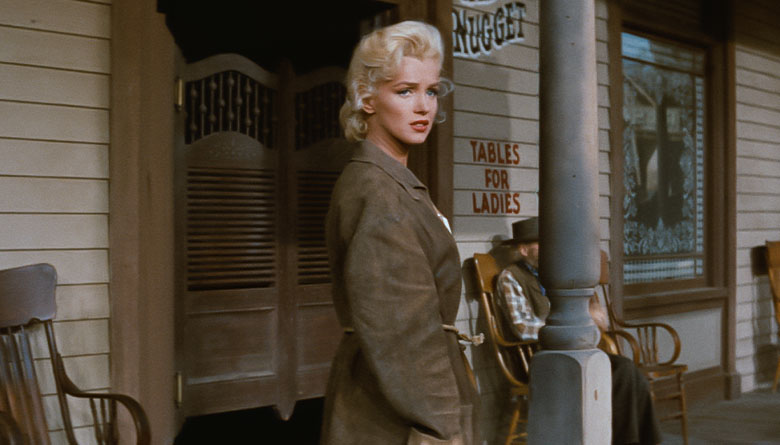Marilyn Monroe

Every cowboy hat turned her way, as Marilyn Monroe brought star power and her sultry ways to saloons in the Western movie, River of No Return in 1954. But before the boots and Hollywood limelight, many doubted she’d make it in Tinsel Town.
Monroe was born Norma Jean Mortenson on June 1, 1926, in Los Angeles, California. Monroe had humble beginnings, spending the majority of her childhood living in 12 foster homes and an orphanage. To avoid becoming a ward of the state, she married her first husband, James Dougherty, at age 16. When Dougherty enlisted in the military during World War II, Monroe began working in a factory which led to one of her first big breaks: she met a photographer who began her career as a pinup model. By 1946, she had appeared on 33 magazine covers and in numerous publications and advertisements. It was during this time that she dyed her hair blonde and straightened it.
In June 1946, she signed a six-month contract with 20th Century Fox. She and Ben Lyon, an executive at 20th Century Fox, chose her new stage name, Marilyn Monroe. Lyon was reminded of the Broadway star Marilyn Miller, and Monroe was her mother’s maiden name. As her Hollywood chapter began, Monroe divorced her husband Dougherty in September 1946, as he wasn’t supportive of her new career.
Monroe soon landed parts in Dangerous Years! (1947) and Scudda Hoo, Scudda Hay! (1948). By 1951, her star began taking fast flight. She signed with Columbia Pictures that year, and had supporting roles in three movies that received success at the box office: As Young As You Feel, Love Nest, and Let’s Make it Legal. She began receiving thousands of letters and fan mail every week. Her private life began grabbing the public’s attention as she dated actors and other men in the spotlight. In 1952, she began dating retired baseball legend Joe DiMaggio, who was one of the biggest stars in sports at the time.
By 1953, Monroe was cemented as a major sex symbol and bankable Hollywood Actress. Her film Niagara (1953) established her sultry iconic look of arched brows, pale makeup, shiny red lips, and a beauty mark. Her films, Gentlemen Prefer Blondes (1953) and How to Marry a Millionaire (1953) achieved box office success. She followed this success with her marriage to Joe DiMaggio in 1954.
 Later in 1954, Monroe starred in the Western film River of No Return, set in the Northwest. Monroe played a dance hall singer who was taking care of a young boy until his father, played by Robert Mitchum, returned to town. In the film, Monroe experiences numerous adventures outdoors with them that were far different from singing in heels in saloons for Cowboys. The film received moderate success and praise for its beautiful scenes in the river and mountains.
Later in 1954, Monroe starred in the Western film River of No Return, set in the Northwest. Monroe played a dance hall singer who was taking care of a young boy until his father, played by Robert Mitchum, returned to town. In the film, Monroe experiences numerous adventures outdoors with them that were far different from singing in heels in saloons for Cowboys. The film received moderate success and praise for its beautiful scenes in the river and mountains.
Monroe followed up River of No Return with 1955’s The Seven Year Itch. This film includes the now iconic scene of Monroe standing over a subway grate with the wind blowing up her white dress. It’s reported that more than 2,000 spectators watched Monroe and the production for hours as they filmed the scene. In 1955, her marriage to Joe DiMaggio ended, in part because he purportedly was not pleased with the subway grate scene.
In 1956, Monroe married her third husband, playwright Arthur Miller. After production wrapped on the 1956 film, The Prince and the Showgirl, Monroe took a year and a half off from filming to focus on family. During this time, she experienced health problems and a miscarriage. and was also hospitalized due to pharmaceutical drug overdose.
In 1958, Monroe bounced back. She starred in one of her most famous films, Some Like It Hot (1959). The film was met with rave reviews and success, and Monroe won a Golden Globe Award for Best Actress.
Monroe’s challenges on set and pharmaceutical drug addiction followed her on production in her last 1960s film, The Misfits. In August 1960, filming was suspended for a week for Monroe to spend time detoxing in a hospital. Filming ultimately wrapped, and she and Miller separated, then divorced in January 1961.
In 1961, Monroe spent the majority of the year focusing on her health. She also spent four months in the hospital battling depression. During this time, her second husband, Joe DiMaggio helped take care of her as a friend. She also dated his friend Frank Sinatra for several months.
In 1962, Monroe got back on the Hollywood scene and began filming Something’s Gotta Give (1962). But she continued to face health problems and missed weeks of filming. During filming, she took a break to sing her famous rendition of “Happy Birthday Mr. President” to John F. Kennedy at Madison Square Garden that May.
In August 1962, Monroe was found dead in her bed by her housekeeper and her psychiatrist. The cause of death was ruled as an overdose of barbiturates and probable suicide. Hundreds of spectators crowded the streets surrounding the cemetery. While her life and acting career were cut short, Monroe’s legacy continues to impact Hollywood and pop culture. Her off-screen, high-profile relationships kept her in the spotlight and in headlines as much as her movie career. She is still considered to be one of the most iconic international figures in cinema, and influential actresses of the 20th century.
 |
 |



